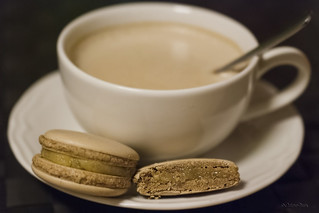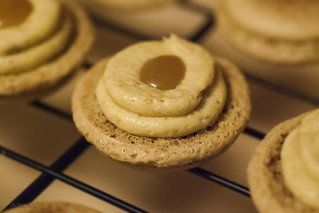Caramel macchiato macarons
Trial #4 of my foray into Italian meringue-based macarons: caramel macchiato macarons—espresso macarons filled with latte macchiato french buttercream with salted caramel sauce in the center. This is actually my second batch… I dare not post photos of the first one because they ended up looking hideous: my timing was off in heating the sugar syrup and adding it to the egg whites to make the meringue, as well as overbeating the batter a wee bit; the result were flat macarons with thick lips instead of tiny feet (still tasted good though). This batch is a bit better, but not perfect. This time around, my trusted Kenwood Chef A701A (aka Kenny) died while I was in the midst of making the meringue, so I had to continue using a hand mixer instead. The resulting meringue was not as thick and stiff as it should be, which may have affected the resulting macarons.*
* the batter was already a bit runny in the beginning, so some of the macarons had air pockets under the caps. The air pockets could also be the result of poor meringue that collapsed during baking. LESSON: hand mixers are great when making French meringue, but not when making Italian meringue.
Caramel macchiato macarons
Espresso macaron shells
Makes about 48 shells (24 filled macarons)
100 g finely ground almonds (almond meal/flour)
100 g confectioner’s sugar
5 g instant espresso powder
1-2 drops coffee essence (i.g. LorAnn Oils)
37 g egg whites (from approximately 1 egg)
100 g granulated sugar
37 g egg whites (from approximately 1 egg)
25 g water
- Line baking trays with baking paper, silicone macaron mats or silpat (I used silpats).
- Tant pour tant: Grind the ground almonds, confectioner’s sugar, and espresso powder in the food processor. Sift the mix into large bowl. Place the pieces that won’t go through the sieve back in the food processor and process until everything goes through the sieve. Make a well in the center of the tant pour tant.
- Stir the coffee essence into the egg whites. Pour the egg white mixture in the middle of the tant pour tant but do not mix. Set aside.
- Italian meringue: Place the water and sugar in an appropriately sized saucepan. Place a digital kitchen thermometer (I used a digital meat thermometer with an alarm function) in the center of the pan with the sugar mixture, and heat over medium heat until the sugar syrup boils and reaches a temperature of 118°C. DO NOT STIR, but you can swirl gently.
- Place the second batch of egg whites in the bowl of a standing mixer fitted with the whisk attachment. When the sugar syrup temperature reaches past 110°C, begin whipping the egg whites at high speed until soft peaks form.
- As soon as the sugar syrup reaches 118°C, remove from heat and pour in a thin stream into the egg whites while continuing to beat at high speed. Beat one more minute, then lower the speed to medium and beat for about 2 more minutes. Cool to 50°C (or lower) before adding into the tant pour tant.
- Macaronage: You can add the meringue in 2 batches (although Pierre Hermé in his book does it in one go). Using a spatula, fold the meringue into the tant pour tant by pressing the batter from the center of the bowl towards the sides, then scraping the batter from the sides and bringing it towards the center. Repeat this pressing and scraping action while rotating the bowl until the batter becomes homogenous in color. Add the second batch of meringue (if using 2 batches), then repeat the pressing, scraping and rotating procedure until the batter becomes shiny and homogenous in color.
- Once the batter is shiny and homogenous, check for the consistency. Using the spatula, lift a small amount of batter and let it drop from the spatula. If the batter drops in clumps, fold a couple more times then check again. The batter is ready for piping when it drops from the spatula in ribbons that smooth themselves back into the rest of the batter within 15-20 seconds. Alternatively, check how the batter flows: tip the bowl slightly to one side and watch how the batter moves. If the batter moves like slowly flowing lava, it is ready.
- Spoon or pour the batter into a piping bag fitted with an 8-10 mm diameter round nozzle (Wilton 1A or 2A), taking care not to add air bubbles into the batter as you are doing so.
- Pipe out 35 mm circles, each about 20 mm apart, onto the prepared baking sheets. Rap the sheets on the counter top to smoothen the tops of the macarons (in case there are stubborn peaks that formed while piping) and to dislodge/remove excess air from the batter.
- Croûtage: Let the macarons rest for 15-30 minutes, or until they have formed a thin crust, their surfaces are dull in color and are no longer sticky when touched.
- Preheat the oven to 150°C-160°C (this depends on your oven; mine is hotter than what it says on the dial, so I use 150°C).
- Once the oven is done preheating and the macarons are dry and ready, place one of the baking sheets on the lower third of the oven—you can only bake one sheet at time. Bake for 10-12 minutes (again, this depends on your oven; in my case, I check for doneness after 10 minutes), briefly opening the oven at least once after 8 minutes to let out steam/moisture. The macarons are ready when the tops are firm to the touch and they do not wobble.
- Remove from the oven and slide the baking paper/silicone/silpat with the macarons still on it from the baking sheet onto a wire rack. Let the macarons cool on the baking paper/silicone/silpat. Once cooled, they can be removed easily from the baking surface (peel the baking surface from the macarons, and not vice-versa); any macaron with the bottom still stubbornly sticking to the baking surface is undercooked—pop them back into the oven and bake a couple more minutes.
- Pair the finished macarons and allow to rest on wire racks with half of them lying foot side up. Cool completely before piping the filling.
Latte macchiato buttercream
2 egg yolks
67 g caster sugar
1 tbsp instant latte macchiato powder (alternatively: 1 tsp espresso powder mixed with 2 tsp milk powder or coffee creamer)
84 g (3 oz.) unsalted butter, diced into 1 cm cubes, at room temperature
- In a bowl, beat the egg yolks with the caster sugar at high speed until the mixture becomes fluffy and doubles in volume.
- Pour the egg mixture into a saucepan over medium heat. Add the latte macchiato powder and stir continuously until the mixture forms a uniform and compact batter.
- Pour the batter into a shallow dish, cover with a plastic wrap, and let cool in the refrigerator.
- In the bowl of a standing electric mixer fitted with a paddle attachment, beat the unsalted butter at high speed until light and creamy, then add the chilled coffee batter. Continue whipping until the mixture becomes homogenous.
- Spoon into a piping bag fitted with 8 mm diameter round nozzle (Wilton 2A). Store in the refrigerator until ready for use.
Salted caramel sauce
Adapted from Cooking Classy
100 g granulated sugar
3 tbsp water
31 g salted butter, cut into cubes
60 ml heavy cream
1/4 tsp fine sea salt (or 1/2 tsp Maldon salt), more if desired
- Gather all the ingredients and place them nearby, ready to add into the mixture as needed.
- Heat the water and sugar in a medium heavy-bottomed saucepan at medium-high heat, whisking to help dissolve the sugar. Stop whisking when the mixture comes to a boil.
- Let the mixture boil, carefully swirling the pan occasionally, until it reaches a dark amber color.
- Once the mixture is dark amber in color, immediately add the butter. Whisk until the butter has melted, then immediately remove from the heat.
- Carefully pour in the cream and immediately whisk to combine (Note: mixture will bubble vigorously). Whisk until mixture is smooth.
- Stir in the sea salt.
- Pour caramel into a glass jar/bowl to cool. Store in airtight containers in the refrigerator once cooled; the caramel will keep for 2 weeks.
Assembly
- Pipe the buttercream onto half of the macarons (those with the foot side facing upwards), leaving about 3 mm from the edges and the center free.
- Pipe, or spoon the salted caramel sauce in the center of the buttercream.
- Top with the remaing macarons.
- Leave the macarons to «mature» with the fillings for 24 hours, or at least overnight.




Comments